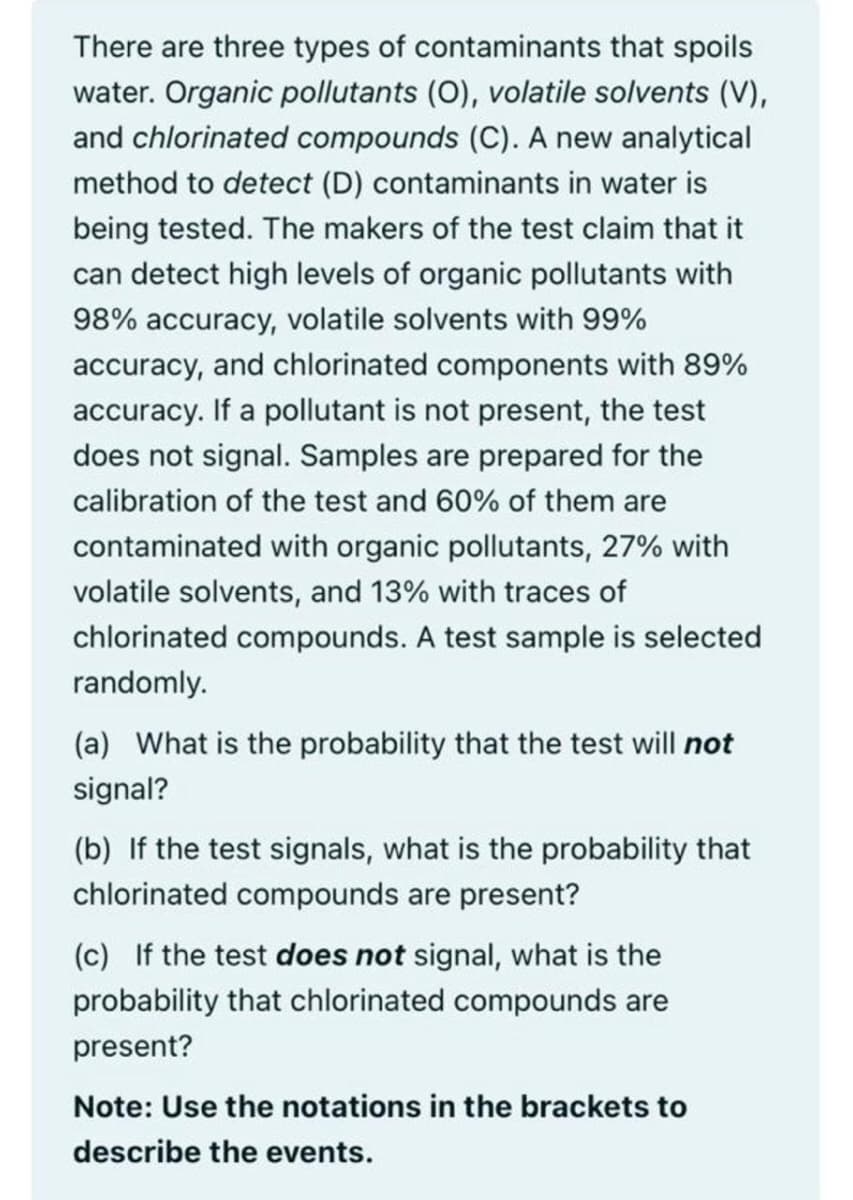There are three types of contaminants that spoils water. Organic pollutants (O), volatile solvents (V), and chlorinated compounds (C). A new analytical method to detect (D) contaminants in water is being tested. The makers of the test claim that it can detect high levels of organic pollutants with 98% accuracy, volatile solvents with 99% accuracy, and chlorinated components with 89% accuracy. If a pollutant is not present, the test does not signal. Samples are prepared for the calibration of the test and 60% of them are contaminated with organic pollutants, 27% with volatile solvents, and 13% with traces of chlorinated compounds. A test sample is selected randomly. (a) What is the probability that the test will not signal? (b) If the test signals, what is the probability that
There are three types of contaminants that spoils water. Organic pollutants (O), volatile solvents (V), and chlorinated compounds (C). A new analytical method to detect (D) contaminants in water is being tested. The makers of the test claim that it can detect high levels of organic pollutants with 98% accuracy, volatile solvents with 99% accuracy, and chlorinated components with 89% accuracy. If a pollutant is not present, the test does not signal. Samples are prepared for the calibration of the test and 60% of them are contaminated with organic pollutants, 27% with volatile solvents, and 13% with traces of chlorinated compounds. A test sample is selected randomly. (a) What is the probability that the test will not signal? (b) If the test signals, what is the probability that
Chapter6: Systems Of Equations And Inequalities
Section: Chapter Questions
Problem 17PS: Cholesterol Cholesterol in human blood is necessary, but too much can lead to health problems. There...
Related questions
Question

Transcribed Image Text:There are three types of contaminants that spoils
water. Organic pollutants (0), volatile solvents (V),
and chlorinated compounds (C). A new analytical
method to detect (D) contaminants in water is
being tested. The makers of the test claim that it
can detect high levels of organic pollutants with
98% accuracy, volatile solvents with 99%
accuracy, and chlorinated components with 89%
accuracy. If a pollutant is not present, the test
does not signal. Samples are prepared for the
calibration of the test and 60% of them are
contaminated with organic pollutants, 27% with
volatile solvents, and 13% with traces of
chlorinated compounds. A test sample is selected
randomly.
(a) What is the probability that the test will not
signal?
(b) If the test signals, what is the probability that
chlorinated compounds are present?
(c) If the test does not signal, what is the
probability that chlorinated compounds are
present?
Note: Use the notations in the brackets to
describe the events.
Expert Solution
This question has been solved!
Explore an expertly crafted, step-by-step solution for a thorough understanding of key concepts.
Step by step
Solved in 2 steps with 2 images

Knowledge Booster
Learn more about
Need a deep-dive on the concept behind this application? Look no further. Learn more about this topic, probability and related others by exploring similar questions and additional content below.Recommended textbooks for you


Glencoe Algebra 1, Student Edition, 9780079039897…
Algebra
ISBN:
9780079039897
Author:
Carter
Publisher:
McGraw Hill


Glencoe Algebra 1, Student Edition, 9780079039897…
Algebra
ISBN:
9780079039897
Author:
Carter
Publisher:
McGraw Hill